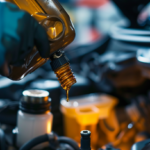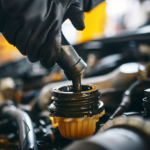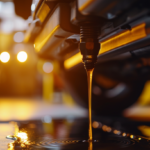Want to boost your car’s braking performance? Look no further! In this article, we’ll show you how to enhance your stopping power and ensure a safer ride. Assess your braking system, upgrade your brake pads and rotors, optimize your brake fluid and lines, adjust your brake bias and balance, enhance cooling and ventilation, and master essential braking techniques. Get ready to take control of your car’s safety and performance. Let’s dive in!
Assessing Your Braking System
You should start by checking the condition of your braking system. Regularly assessing your braking system is crucial to ensure optimal performance and safety on the road. Begin by inspecting the brake pads for any signs of wear and tear. If they are worn down, it is essential to replace them immediately. Additionally, examine the brake rotors for any signs of damage or warping. Warped rotors can cause vibrations and reduce braking efficiency. Next, check the brake fluid level and ensure it is at the recommended level. If it is low, top it up with the appropriate fluid. Lastly, inspect the brake lines for any leaks or damage. If you notice any issues during your assessment, it is important to have them addressed by a professional mechanic to maintain the effectiveness of your braking system.
Upgrading Brake Pads and Rotors
Consider upgrading your brake pads and rotors to improve your car’s braking performance. Upgrading your brake pads and rotors is a great way to enhance your car’s stopping power and overall safety. Brake pads and rotors are essential components of your car’s braking system, and over time, they can wear down and become less effective. By upgrading to high-performance brake pads and rotors, you can significantly improve your car’s braking performance. High-performance brake pads are made from advanced materials that provide better friction and heat resistance, allowing for more efficient stopping power. Similarly, upgrading your rotors to slotted or drilled ones can enhance heat dissipation and reduce brake fade. Remember to choose brake pads and rotors that are compatible with your car’s make and model for optimal performance.
Optimizing Brake Fluid and Lines
To optimize your car’s braking performance, you need to pay attention to the maintenance of your brake fluid. Regularly checking and replacing the brake fluid ensures that it remains in good condition, preventing brake fade and maintaining optimal braking power. Additionally, upgrading your brake lines to stainless steel ones can improve the responsiveness and durability of your braking system, giving you better control and confidence on the road.
Brake Fluid Maintenance
When it comes to optimizing your car’s brake fluid and lines, it’s important to regularly check and maintain them. Brake fluid plays a critical role in your vehicle’s braking system, as it transfers the force from the brake pedal to the wheels. Over time, brake fluid can become contaminated with moisture, dirt, and debris, which can affect its performance and lead to brake failure. To ensure optimal braking performance, it is recommended to flush and replace your brake fluid every two years or as specified by your vehicle’s manufacturer. Additionally, inspecting the brake lines for any signs of leaks, corrosion, or damage is crucial. Addressing any issues promptly will help prevent brake fluid leaks and ensure the integrity of your braking system. Remember, proper brake fluid maintenance is essential for your safety on the road.
Upgrading Brake Lines
To maximize your car’s braking performance, you should also upgrade the brake lines and ensure they are in optimal condition. Upgrading your brake lines can significantly improve the overall effectiveness of your brakes. Stock brake lines are typically made of rubber, which can expand under pressure and result in a spongy pedal feel. By upgrading to stainless steel lines, you can eliminate this expansion and provide a firmer and more responsive brake pedal. Stainless steel lines also have increased durability and resistance to corrosion, ensuring a longer lifespan for your braking system. Additionally, it is crucial to inspect your brake lines regularly for any signs of wear or damage. Any cracks or leaks should be addressed immediately to maintain the integrity and performance of your braking system.
Adjusting Brake Bias and Balance
Make sure you regularly check and adjust the brake bias and balance of your car for optimal braking performance. Brake bias refers to the distribution of braking force between the front and rear wheels, while brake balance refers to the distribution of braking force between the left and right wheels. It is important to have the correct brake bias and balance to ensure that your car stops evenly and efficiently. To adjust the brake bias, you can use a brake proportioning valve or adjust the brake pressure manually. To adjust the brake balance, you can use a brake bias adjuster or adjust the brake pad material. Regularly monitoring and adjusting the brake bias and balance will help improve your car’s braking performance and ensure your safety on the road.
Enhancing Cooling and Ventilation
Improve the cooling and ventilation of your car to enhance its braking performance. Adequate cooling and ventilation are crucial for maintaining the efficiency of your car’s braking system, especially during intense driving conditions. One way to enhance cooling is by upgrading the brake cooling ducts. These ducts help to direct cool air towards the brakes, preventing them from overheating. Additionally, consider installing larger brake rotors with cooling fins. These fins increase surface area and promote better heat dissipation, keeping the brakes cooler for longer periods. Another option is to upgrade to high-performance brake pads that are designed to withstand higher temperatures. These pads have better heat resistance and provide improved stopping power. Lastly, ensure that your car’s cooling system is in good working condition, as it plays a significant role in maintaining the optimal temperature for the brakes. By enhancing cooling and ventilation, you can significantly improve your car’s braking performance.
Mastering Braking Techniques
To improve your braking performance, it’s important to master certain techniques. First, focus on applying proper pedal pressure to maintain control and prevent skidding. Additionally, regular brake fluid maintenance is crucial for optimal performance. Lastly, consider upgrading your brake components to enhance stopping power and responsiveness.
Proper Pedal Pressure
Get a feel for the brake pedal by gradually applying pressure as you slow down. By doing this, you can gauge the amount of force needed to stop your car smoothly and efficiently. Start by gently pressing down on the pedal and gradually increase the pressure as you decelerate. This will help you develop a sense of how much pressure is required for different braking situations. Remember to maintain a firm and steady grip on the pedal, as jerky or sudden movements can lead to skidding or loss of control. Additionally, avoid stomping on the pedal, as this can cause the brakes to lock up and the tires to lose traction. With practice, you will be able to master the art of proper pedal pressure and enhance your car’s braking performance.
Brake Fluid Maintenance
Check your car’s brake fluid regularly, as it is essential for maintaining optimal braking performance. Brake fluid plays a crucial role in the braking system by transmitting pressure from the brake pedal to the brake calipers, which then applies the necessary force to stop the vehicle. Over time, brake fluid can become contaminated with moisture, dirt, and debris, which can negatively impact its performance. This can lead to reduced braking efficiency and potentially dangerous situations on the road. To ensure your brake fluid is in good condition, start by checking its level and color. If the fluid appears dark or has a milky appearance, it may be time for a replacement. Additionally, consider flushing and replacing the brake fluid every two to three years or as recommended by your vehicle’s manufacturer. By maintaining your brake fluid, you can enhance your car’s braking performance and overall safety.
Upgrading Brake Components
Improve your car’s braking performance by upgrading brake components and mastering braking techniques. Upgrading your brake components can significantly enhance your car’s stopping power and overall safety. Consider replacing your stock brake pads with high-performance ones that offer better friction and heat resistance. Upgrading to larger brake rotors can also improve braking performance by increasing the surface area for heat dissipation. Additionally, installing stainless steel brake lines can provide a firmer pedal feel and reduce brake fade. Alongside upgrading brake components, mastering proper braking techniques is essential. Remember to apply gradual and consistent pressure to the brake pedal, rather than slamming it down abruptly. Also, practice threshold braking, which involves applying maximum braking force without the wheels locking up. With these upgrades and techniques, you can achieve improved braking performance and have better control over your car.

Lucas is an experienced vehicle technician with hands-on knowledge of almost every car brand available. Throughout his career, Lucas has worked on a wide range of vehicles, including domestic and foreign models, sports cars, trucks, and SUVs.





